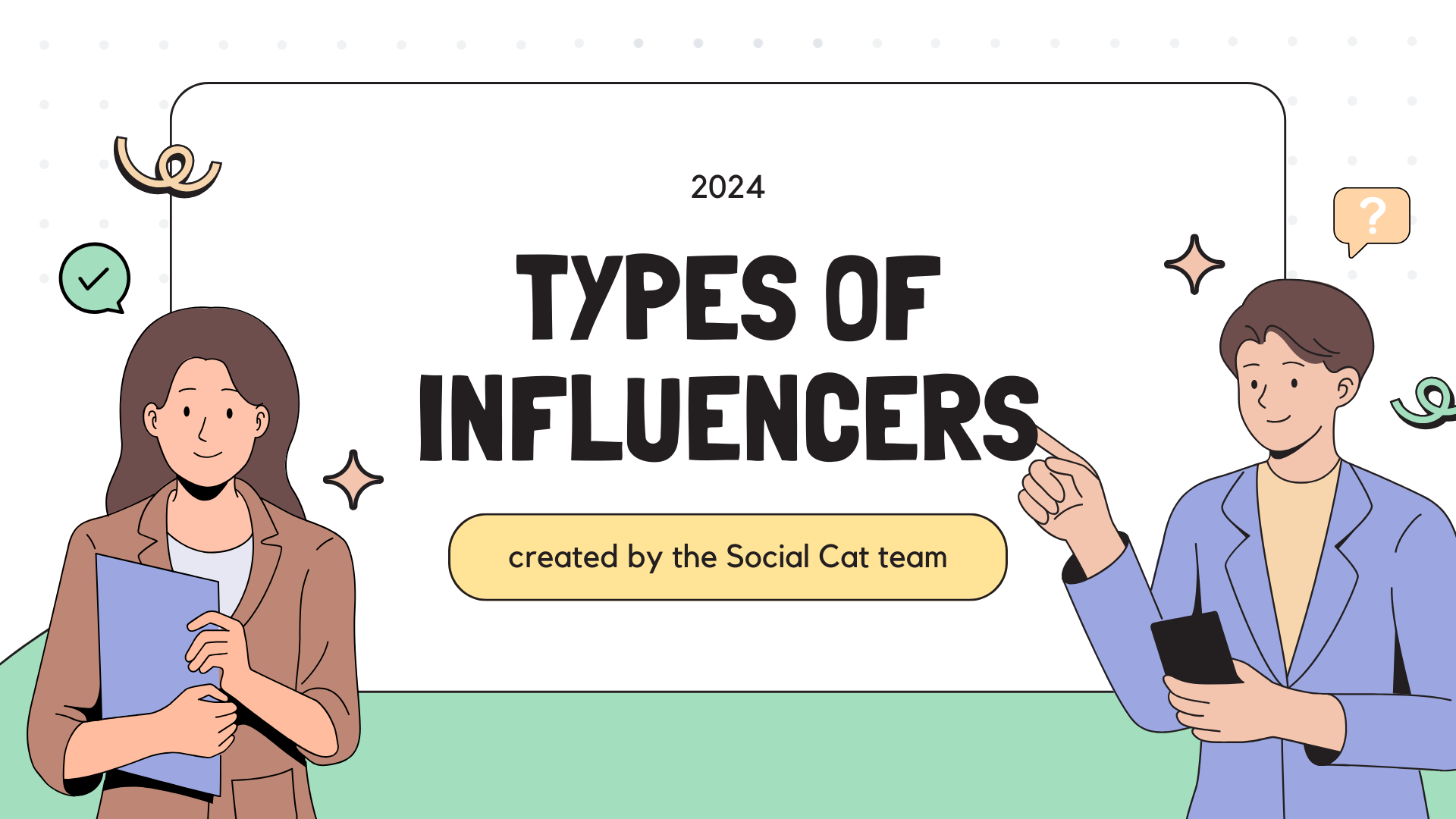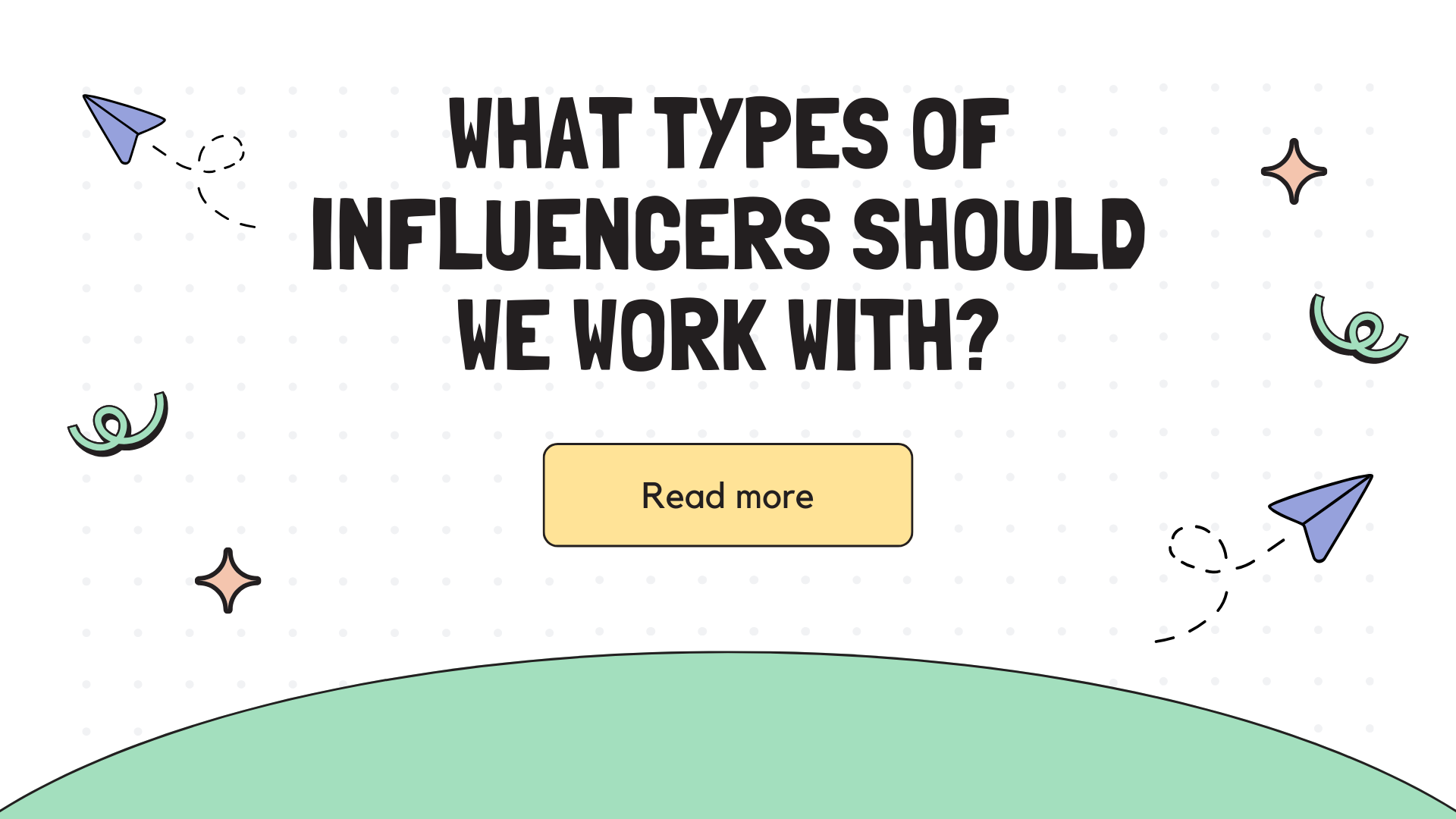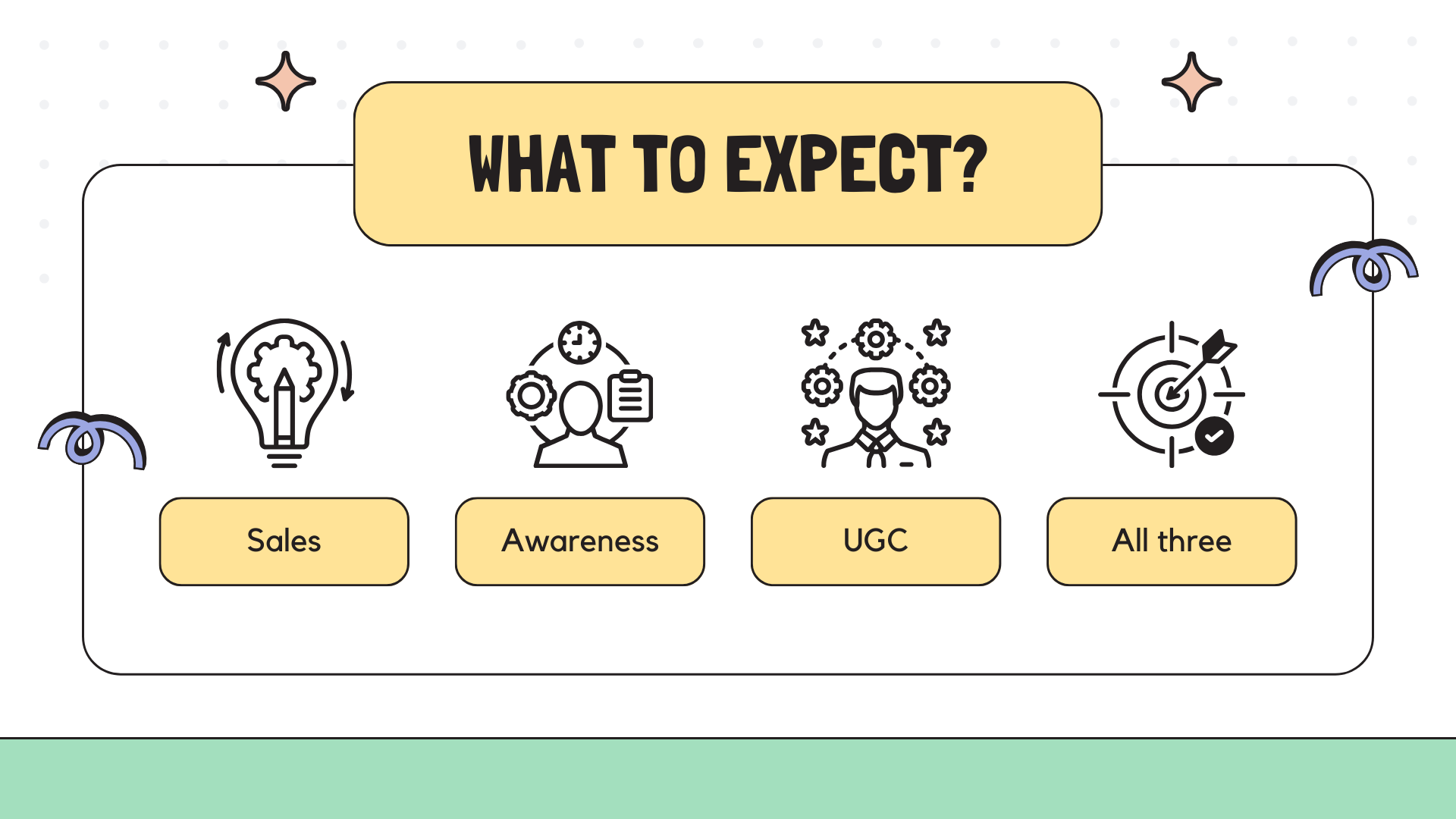What we’re about to say may rock your world:
Choosing influencers who will help your brand go viral isn’t always the best choice.
Unless you’re already an established brand with lots of cash flow… We wouldn’t recommend chasing the types of influencers who promise to help you go viral.
There are way better options. And don’t worry– we’ll talk about them.
But first, we need to talk about:
- The types of social media influencers you can hire
- Some pros and cons of each category (Honest opinions only)
- The types of influencers your brand should work with, based on a couple of factors.
Then we can discuss what to aim for with influencers.
If you’ve read some of our other articles, you may feel like we’re repeating things we’ve already said.
But if you have questions about the types of influencers out there, this article is the most comprehensive answer.
One more note– these categories apply across social media platforms, so if you’re looking for different types of Instagram influencers, TikTok influencers, or YouTube influencers, we’ve got you covered. 😉
The 4 types of influencers to hire in 2024, plus advantages and disadvantages
Before we talk about different types of social media influencers, let’s make sure we have clear expectations:

Let’s talk about what an influencer is not.
An influencer is not a content creator. Yes, content creation is part of their job, but it’s not the only skill you’re paying them for.
No, an influencer has a community around them. Part of what you’re paying for access to it. Call it marketing savvy, audience-building, or whatever you want– but their ability to help your brand resonate with their followers is their true expertise.
As we look at the different types of influencers, the only thing that separates the categories is the number of followers. If you’re trying to categorize influencers, metrics like reach and impressions don’t matter.
***Of course, metrics do matter when you’re trying to figure out if working with a particular influencer is a good investment. But that’s not the question we’re addressing here.
You may find other sources that play with these numbers a bit– no one source says *exactly* where these categories fall. We’ve based our categories on over 10 years of experience in the influencer marketing space– so we like to think we know what we’re talking about. 😂
Here are the different types of influencers on social media:
Nano influencers
Nano influencers at-a-glance:
- Number of followers: 1,000-5,000
- Platforms: TikTok, Instagram, and YouTube
- Collaboration type: Mostly gifted collabs
Advantages:
- Amazing engagement: Nano influencers are super niched, so even though their audience is small, they’re very loyal and responsive to what the influencer posts.
- Affordable: Gifted collaborations are the norm, which means you don’t have to spend tons of money on influencer fees.
- Responsive: They’re easy to reach, especially if you compare them to big influencers. They’ll also give you honest feedback on your brand and products.
- More potential for sales: Because their followers are engaged and highly niched, you have a better chance of making sales.
Relationship opportunities: If you find a nano influencer who loves your brand and makes effective content, it’s much easier to negotiate ongoing collaborations– great for long-term brand awareness and customer retention.
Disadvantages:
- Small reach: Your brand awareness won’t be as great as with other types of influencers. However, reaching more eyeballs doesn’t automatically translate into more sales– their audiences are often way more responsive to recommendations.
- More potential for low quality: Their video quality might fluctuate– check their portfolio before agreeing to work with them.
- Guidance needed: Because they’re new to making content for brands, they may need a bit more hand-holding than your average influencer. Be prepared to guide them.
Example:
Here’s an example of a nano influencer who’s rocking it on Instagram - Magdalene Kan (@magzkan). You can connect with her on Social Cat. ❤️
Micro-influencers
Micro-influencers at-a-glance:
- Number of followers: 5,000-50,000
- Platforms: TikTok, Instagram, and YouTube
- Collaboration type: Gifted, affiliate, and paid collaborations. However, as their follower counts grow, they do fewer gifted and affiliate collabs.
Advantages:
- Better reach: Especially compared with nano influencers, they get your brand in front of more people because they have more followers.
- Engagement: Their engagement rates are still good, especially if they’re focused on their niche and under 10K followers. This is the sweet spot between nano and micro influencers– where they’re big enough to get you reach, but still small enough to have an engaged following.
- Affordable: Generally, micro-influencers are affordable– however, this *might* depend on their metrics.
- More potential sales: This isn’t a guarantee, but IF their engagement is high, they’re still niched, and your brand fits within that niche, you may see more sales than you would with nano influencers. It depends on all those factors, though, so don’t assume it’ll happen.
Disadvantages:
- Less responsive: Micro-influencers are harder to reach since they have ongoing collaborations already. As their content quality and follower counts grow, they become less responsive.
- Audience concerns: Be aware of how they grew their accounts: Did they buy followers? Have they done follow-for-follow loops? Have they stayed true to their niche, or are people starting to disengage? These questions can help you assess how healthy their audience is.
Here’s an example of a nano influencer who’s rocking it on Instagram - Sam Bonnor (@sambonnor). And… You guessed it - You can connect with her on Social Cat. ❤️
Macro influencers
Macro influencers a glance:
- Number of followers: 50,000-500,000
- Platforms: TikTok, Instagram, and YouTube
- Collaboration type: Mostly paid. However, if they like the brand and its mission, they might make an exception. We see this happen quite a bit on Social Cat!
Advantages
- Higher reach: The potential to get your brand in front of TONS of people is here– just make sure you know how they got their followers. Use a fake follower checker to make sure their followers are real before you reach out. If they are? Well, you might’ve just stumbled on a gold mine.
- Great sales potential: Again, this comes with a few caveats. If their reach and followers are legit, and they are particularly focused on a specific niche, then you’re looking at a huge opportunity for sales.
- Quality content: In 90% of cases macro influencer content is good. Of course, make sure you check their portfolio to do your due diligence.
- Engagement: This can be an advantage or a disadvantage, depending on the influencer. It depends a lot on things like the types of content they post, if they’ve expanded into other niches, and how much effort they put into engaging with their audience (like responding to comments on their profile). Generally, the more focused they are on their niche and interacting with their audience, the better their engagement will be.
Disadvantages
- Expensive: Macro influencers are expensive to work with– after all, they’re introducing your brand to a large audience. Unfortunately, they’re not always worth what they cost– it depends on their metrics and marketing skills.
- Not responsive: It’s generally difficult to reach macro influencers, as there are so many brands clamoring for their attention and work.
- Fewer payment options: Generally, they only do paid collaborations. If you’re hoping to run gifted or affiliate promotions, a macro influencer is probably out of your league.
- Less engaged: The more an influencer grows, the less engaged they are with their audience– and vice versa. This happens pretty naturally, and it doesn’t mean the influencer is bad– it just means that they started expanding into other niches and lost the part of their audience that was super loyal and locked in when they started growing.
Example:
Sarah Steven (@shipponbarn) is a great example of a macro influencer in the home space. … And yep! You can reach Sarah directly on Social Cat!
Mega influencers
Mega influencers at-a-glance:
- Number of followers: 500,000+
- Platforms: Any platform you can dream of. At this point, they usually have teams around them and build an entire brand out of it. So, they have the resources to have a strong presence on multiple platforms.
- Collaboration type: Paid. Gifted and affiliate deals are extremely rare.
Advantages
- Viral potential: Getting a mega influencer on board boosts your chances of going viral– under certain conditions, they may also be about to get you tons of sales.
- High visibility: When looking at reach, no one beats mega influencers. However, it’s hard to tell if their audience will be interested in your brand. There’s a high chance that you won’t be introduced to the right people because their audience is too huge.
- Credibility: If they’ve built a trusted persona, they can help build trust for your brand. For example, if Neil Patel recommends a marketing tool… I’ll probably believe him.
Disadvantages
- Impossible to reach: Seriously. If macro influencers are hard to reach, mega influencers are even harder– especially if you’re not a big brand. Mega influencers have teams around them who vet everything, so your odds of cutting through the noise are small.
- Even more expensive: We’re talking thousands of dollars. People whose livelihood is their brand don’t come cheaply.
- Risky: The ROI for mega influencers can be huge… But it’s often small. You’re placing a big bet that this influencer will be effective for your brand. It might work out… But unless you have a huge marketing budget, we don’t recommend it.
An example of a mega influencer in the fitness industry would be Andrei Deiu (@andreideiu_).
You can find Andrei on some influencer databases, but it will probably be extremely hard to reach him as he has a team that manages his entire social media strategy.
What types of influencers should my brand work with?
This depends on a lot of factors– there’s no one-size-fits-all answer.

But, we’ll try to give you some guidelines you can use to find the best influencer for your brand!
If you’re a small or medium-sized company, the types of influencers your brand should work with will be determined by your budget.
So start working with nano influencers first, then ramp up to micro influencers. You can work on some gifted collaborations and affordable paid collaborations– which will help you learn a LOT without blowing your entire marketing budget for the year.
Another factor to consider is your comfort level with influencers– if you’ve never worked with influencers before, try some gifted collaborations. It’s affordable, fun, and will give you a lot of insight into what does and doesn’t work for your brand.
If you’re experienced with influencers, then your main consideration is (again) probably going to be your budget. You may want to experiment with nano and micro influencers if you’re rebranding, launching a new product, or changing your messaging at all.
Starting gradually with influencer marketing is the way to go, even if it takes time to gain momentum. Approach it like a thrifty scientist– don’t allocate too many resources to influencer marketing or a particular influencer. Wait to form conclusions until you have enough data to get your intended result. Take it slow.
With nano and micro influencers, you can learn those lessons on an affordable scale.
If budget isn’t a concern for you, then macro influencers are a great option. Although, we recommend also trying some micro influencers and see which ones give you the most ROI.
Finally, try to measure the goal you’re aiming for as much as possible, whether that’s awareness, reach, impressions, engagement, or sales.
If you’re *only* worried about sales, you can track them easily using discount codes and UTM parameters. Then, once you know which campaigns performed best, you can see if there are similarities between the influencers whose campaigns worked for you.
Oh, and if you’re looking just for UGC there are better alternatives. Not to diss influencer marketing (after all, we help influencers and brands start conversations 24/7), but there’s no reason to spend influencer prices if you don’t care about their audience.
What should you expect when working with influencers?
We have some bad news: If you’re a brand owner, and you expect a bunch of sales from your first influencer collaboration… You might be disappointed.

It takes time, financial resources, and A/B testing to nail your messaging and influencer mix.
Plus, there are factors you can’t control– what if the social media platforms change their algorithm again? What if the people who see the post like your product, but need to buy it right now? What if they’re waiting until their next paycheck to buy anything?
There are a million situations that potential customers find themselves in, and you can’t assume that everyone is going to rush to buy your product because they saw it on Instagram.
Our point is: Don’t expect to go viral or sell like crazy after just a few collaborations.
Influencer marketing brings results when it’s done on an ongoing basis, and in the context of a robust, well-rounded marketing strategy.
Yes, you need influencers to sell your products to new audiences, but you also need UGC to post on your social media or run ads. You need a good website. You need hooks and pain points and insight into what resonates with your best customers.
And all of that, unfortunately, takes time. Like any business effort, it won’t happen overnight.
This can be hard to hear, we know. Most brands have dreams of going viral and swimming in cash after just a few influencer posts. And then, when their new Shopify store doesn’t blow up immediately, they say, “Influencers are bad! They're a scam!”
Nope… They’re not a scam. But they’re not a silver bullet, either.
If influencer marketing was easy, everyone would be doing it– right?
So expect some hard work. Expect to learn things along the way.
Expect to find out what makes your brand unique and special, and to meet some amazing creators.
And after you’ve done that work, expect your brand awareness and sales to grow.
If you’re ready to get started… We’d love to help!
Table of content
Looking for influencers?









